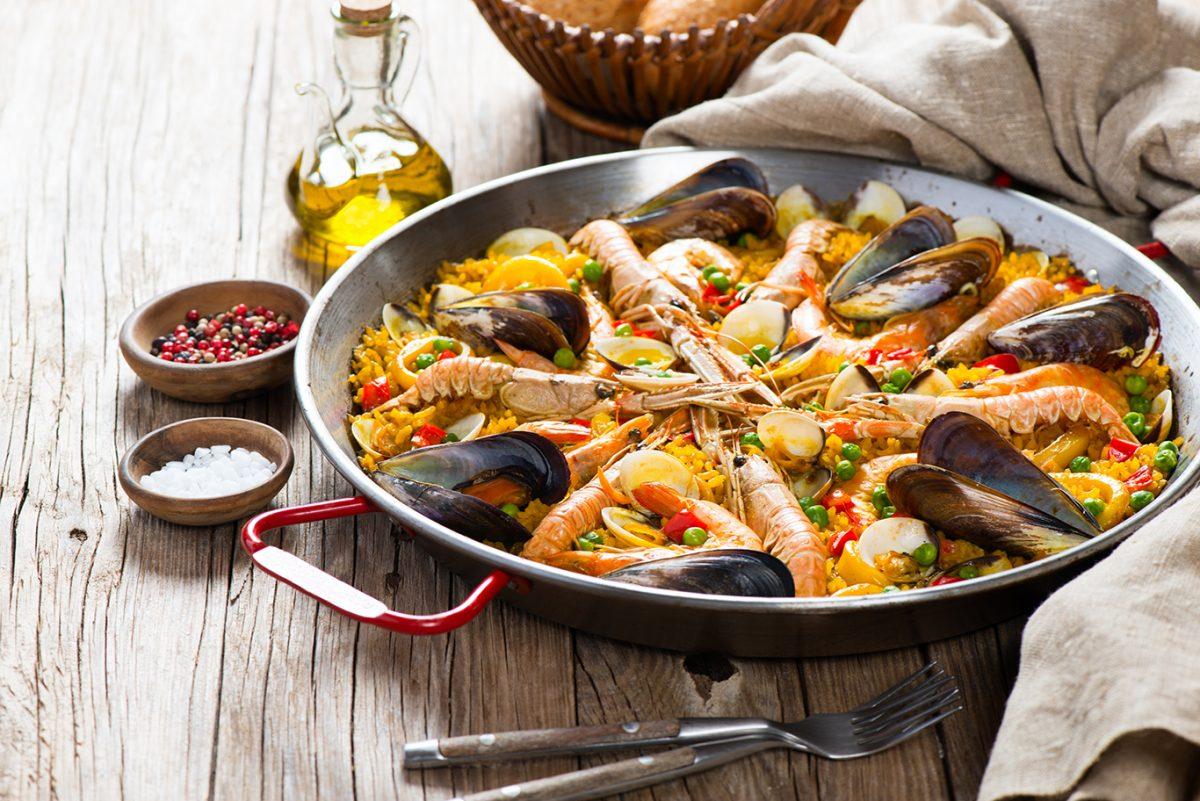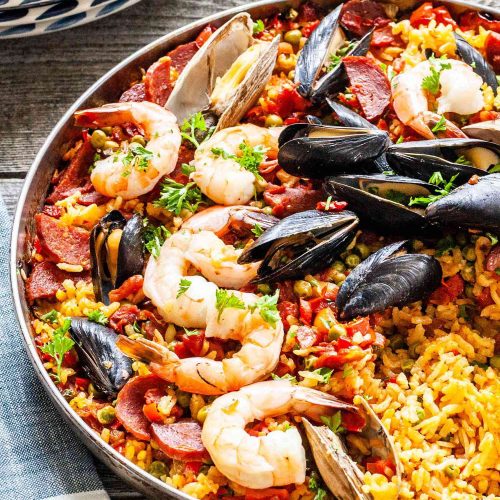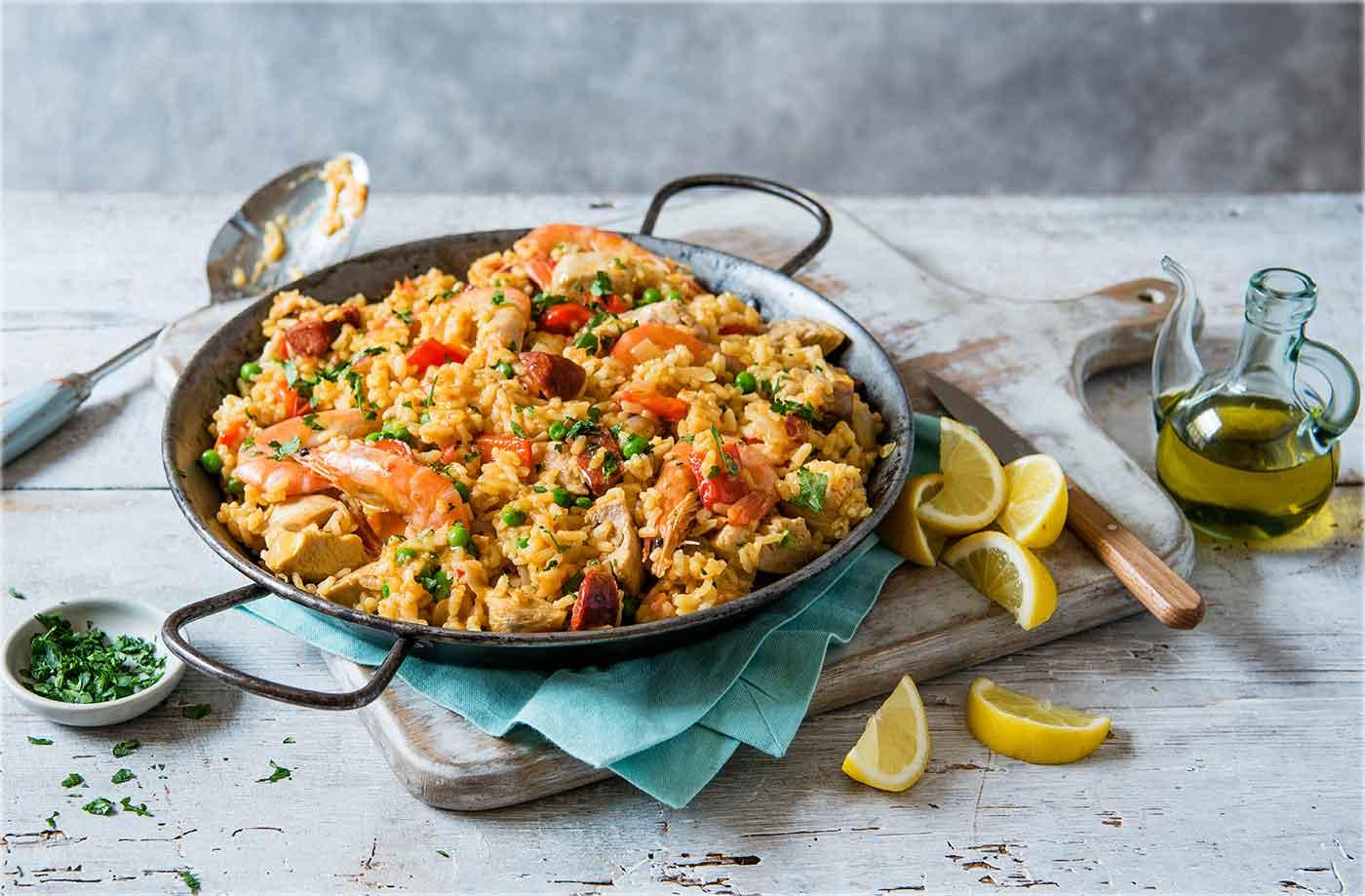Close your eyes and imagine the sun-drenched landscapes of Spain, where the aroma of saffron and the sizzle of fresh seafood fill the air. Today, I’m thrilled to transport you to this culinary paradise with my treasured recipe for traditional Spanish paella. From the perfectly cooked rice to the succulent morsels of meat and seafood, every bite is a symphony of flavors that will transport you to the heart of Spain. Get ready to impress your taste buds and your loved ones with this show-stopping dish.


Traditional Spanish Paella
Equipment
- 1 blender
- 1 large saucepan or skillet
- 1 medium saucepan or skillet
Ingredients
Herb Blend
- 1 tablespoon olive oil
- 2 large cloves garlic, minced
- 1 cup chopped fresh parsley
- 1⁄4 cup fresh lemon juice
Paella
- 3 cans fat-free, less-sodium chicken broth
- 1 cup water
- 1 cup finely chopped red bell pepper
- 1 cup canned diced tomatoes, undrained
- 2 cups finely chopped onion
- 1 teaspoon saffron threads
- 8 jumbo shrimp peeled and deveined with tails intact
- 4 skinless, boneless chicken thighs, halved
- 1 tablespoon olive oil
- 1 slice Serrano ham or other ham, cut into 1-inch pieces
- 2 links Spanish chorizo sausage, cut into 1⁄2-inch-thick slices
- 3 large cloves garlic, minced
- 1 teaspoon sweet paprika
- 1 cup frozen green peas
- 1⁄4 cup lemon juice
- 3 cups Arborio or other short-grain rice, uncooked
- 8 mussels, scrubbed and debearded
- Lemon wedges (optional)
Instructions
- Blend all the herb ingredients in a blender. Set aside.
- Add the broth, water, and saffron to a large saucepan or skillet and heat over medium heat.
- Simmer without boiling. Reduce heat to low.
- Heat 1 tablespoon of olive oil over medium heat in a medium saucepan or skillet.
- Add the chicken and stir cook for 3–4 minutes until evenly brown. Set aside.
- Add the sausage and prosciutto to a pan; stir-cook for 2 minutes and set aside.
- Add the shrimp and stir cook for 2 minutes. Set aside.
- Reduce heat to low, add the onions and bell pepper, and stir-cook for about 15 minutes.
- Add the garlic, tomatoes, and paprika; stir-cook for 4–5 minutes.
- Add the rice; stir-cook for 1 minute.
- Mix in the broth mixture. Add the chicken, sausage mixture, herb mixture, and peas; stir gently.
- Simmer for about 10 minutes over low heat, stirring occasionally.
- Mix in the mussels and cook for about 5 minutes until their shells open up; remove any mussels that don't open up.
- Add the shrimp and stir-cook for 5 minutes until the shrimp are cooked well.
- Mix in the lemon juice. Remove from heat and serve with some lemon wedges.
Video
Notes
Alternative Method: Pressure Cooker

If you’re looking for a time-saving method to prepare traditional Spanish paella, utilizing a pressure cooker can be a game-changer. This appliance will help you achieve delicious results in a fraction of the time. Here’s a step-by-step guide to preparing paella using a pressure cooker:
- Sauté the aromatics: Start by using the sauté function on your pressure cooker to heat olive oil. Add diced onions, minced garlic, and any other aromatic ingredients you prefer, such as bell peppers or tomatoes. Sauté until the onions become translucent and the aromatics release their flavors.
- Add the rice and spices: Stir in the short-grain rice, ensuring it’s well-coated with the oil and aromatic mixture. Add the desired spices, such as saffron threads, smoked paprika, and a pinch of salt. Toast the rice and spices for a few minutes to enhance their flavors.
- Pour in the broth and combine: Pour the broth into the pressure cooker, ensuring it covers the rice and ingredients. Give it a gentle stir to distribute the flavors evenly.
- Secure the lid and set the pressure cooker: Close the pressure cooker securely with its lid. Follow the manufacturer’s instructions to set the pressure cooking function. Set the cooking time according to the type of rice you’re using and the manufacturer’s recommendations. Typically, 5-7 minutes at high pressure should be sufficient.
- Natural release and fluff the rice: Once the cooking time is complete, allow the pressure to release naturally for about 5-10 minutes. Then, carefully release any remaining pressure according to the manufacturer’s instructions. Open the lid and fluff the rice gently with a fork.
- Check for the socarrat: If you desire a caramelized crust on the bottom of the rice, transfer the paella to a stovetop skillet. Cook it over medium heat for a few minutes, allowing the bottom layer to crisp up and develop the socarrat. Keep a close eye on it to prevent burning.
- Rest and serve: Once you achieve the desired socarrat, remove the paella from the heat. Let it rest for a few minutes to allow the flavors to meld together. Garnish with lemon wedges and fresh parsley for a vibrant presentation. Serve the paella directly from the pressure cooker or transfer it to a serving dish, ensuring each portion includes a bit of the delicious socarrat.
By utilizing a pressure cooker, you can significantly reduce the cooking time while still achieving a delectable paella. This method tenderizes the rice and infuses it with the flavors of the aromatics and spices. Enjoy your quick and flavorful traditional Spanish paella!
Cooking Tips

To truly master the art of traditional Spanish paella, it’s essential to have a few expert cooking tips up your sleeve. These valuable insights will help you achieve the best results and avoid common pitfalls that can hinder the dish’s full potential. Let’s dive into the world of paella preparation and uncover the secrets to cooking perfection.
The Rice Matters: Choosing the Right Variety
Selecting the right rice is crucial for achieving the desired texture and consistency in your paella. Opt for short-grain rice varieties like Bomba or Calasparra, known for their ability to absorb flavors and remain firm without turning mushy. These varieties have a higher starch content, which contributes to the creamy and velvety texture of a well-executed paella.
Patience is a Virtue: Sautéing and Simmering Techniques
To build depth of flavor, take the time to properly sauté the onions, garlic, and other aromatic ingredients before adding the rice and broth. This step allows the flavors to develop and infuse into the dish. Once the broth is added, resist the temptation to stir the rice excessively. Instead, let it simmer undisturbed, allowing the flavors to meld together and the socarrat to form.
The Socarrat Secret: Achieving the Coveted Crust
The socarrat, a caramelized layer of rice at the bottom of the pan, is the crowning glory of a well-executed paella. To achieve this delectable crust, increase the heat slightly during the final minutes of cooking. This will create the perfect balance between a tender rice texture and a crispy bottom layer. The tantalizing combination of textures will add an extra layer of complexity to each bite.
Serving Suggestions
:max_bytes(150000):strip_icc()/SES-seafood-paella-recipe-7106702-hero-01-de73366ad4a64c61924627ee870eabad.jpg)
Now that you’ve mastered the art of cooking traditional Spanish paella, it’s time to delve into the exciting world of serving and enjoying this exquisite dish. From intimate gatherings to festive celebrations, traditional paella is a versatile culinary masterpiece that caters to various occasions. Let’s explore the best ways to present and enhance this delightful dish, ensuring an unforgettable dining experience.
Pairing Perfection: When to Serve Traditional Spanish Paella
Traditional Spanish paella is a showstopper that deserves to be at the center of attention. Its vibrant colors and robust flavors make it ideal for special occasions, such as birthdays, anniversaries, or holiday feasts. It also shines as the star of a themed dinner party, transporting your guests to the lively streets of Spain. Whether you’re hosting an intimate gathering or a larger event, paella will undoubtedly leave a lasting impression.
Flavors That Harmonize: Complementing Sides, Garnishes, and Beverages
To elevate the paella experience, consider serving it with a variety of delicious accompaniments. Start with a refreshing green salad tossed in a tangy vinaigrette to balance the richness of the dish. A crusty baguette or garlic bread is perfect for savoring every last drop of the flavorful broth. For a touch of elegance, offer a selection of Spanish olives or marinated artichoke hearts as palate cleansers. To enhance the authenticity, pair the paella with a glass of crisp Spanish white wine or a refreshing pitcher of sangria.
Creative Presentations: Serving Traditional Spanish Paella
While the traditional presentation of paella in a large communal pan is a sight to behold, there are other creative ways to serve this iconic dish. For a more intimate gathering, consider plating individual portions on vibrant, oven-safe plates. Arrange a few lemon wedges and a sprinkle of fresh parsley on top for a pop of color. Alternatively, you can serve paella in small ceramic cazuelas, allowing each guest to enjoy their own personal serving.
Leftover Love: Storing and Reheating Paella
If you’re fortunate enough to have leftovers, storing them properly will ensure their deliciousness for another day. Transfer the remaining paella to an airtight container and store it in the refrigerator for up to three days. To reheat, gently warm it in a skillet over medium heat, adding a splash of broth to moisten the rice if needed. Avoid using the microwave, as it can make the rice texture mushy. Remember, paella tastes even better the next day as the flavors continue to meld together.
Exploring Beyond Tradition: Creative Paella Variations
While traditional Spanish paella is a timeless classic, don’t be afraid to experiment and put your own spin on this iconic dish. Adapt it to suit your dietary preferences by exploring vegetarian or vegan versions, substituting meat or seafood with flavorful vegetables. You can also try fusion paella incorporating ingredients from other cuisines, such as Mexican, Mediterranean, or Asian flavors. Let your culinary imagination run wild and create a paella that reflects your unique taste and preferences.
FAQs about Traditional Spanish Paella
:max_bytes(150000):strip_icc()/__opt__aboutcom__coeus__resources__content_migration__simply_recipes__uploads__2018__07__Seafood-Paella-HORIZONTAL-ce4d8fe93ec045c0a868ec065f49800a.jpg)
As you embark on your culinary journey to master the art of traditional Spanish paella, it’s natural to have questions along the way. In this section, I’ll address some common queries that may arise during your paella-making adventure. From storage tips to ingredient substitutions, let’s dive into these frequently asked questions and provide you with the answers you seek.
Can I substitute the seafood with other proteins?
Absolutely! While seafood is a traditional choice for Spanish paella, you can experiment with other proteins to suit your taste. Chicken, rabbit, or a combination of both can create equally delicious paella variations. Vegetarian options, such as roasted vegetables or plant-based protein alternatives, can also be incorporated to cater to different dietary preferences. Just ensure that the proteins are cooked thoroughly and harmonize well with the other flavors in the dish.
How do I store leftovers and how long do they last?
To store leftover paella, transfer it to an airtight container and refrigerate it promptly. Properly stored, paella can last for up to three days in the refrigerator. When reheating, it’s best to warm it gently in a skillet over medium heat. You can add a splash of broth to moisten the rice if needed. Avoid using the microwave, as it can compromise the texture of the rice.
Can I make paella in advance for a party?
While paella is best enjoyed immediately after cooking, you can make some preparations in advance to streamline the process. You can pre-measure and chop the ingredients, including the vegetables, proteins, and spices, to save time. However, it’s recommended to cook the rice and assemble the paella just before serving to preserve its optimal texture and flavors.
How can I achieve a vibrant yellow color in my paella?
The vibrant yellow hue of traditional Spanish paella comes from saffron, a highly prized spice. To infuse your dish with this characteristic color, dissolve a pinch of saffron threads in warm water or broth before adding it to the paella. This will release the saffron’s vibrant hues and impart its distinct flavor. Remember, a little goes a long way with saffron, so use it sparingly to avoid overpowering the dish.
Can I make paella without a paella pan?
While a paella pan is the traditional vessel for cooking paella, you can still create a delicious version using a large skillet or a wide, shallow pan. The key is to ensure even heat distribution and a wide surface area to allow the rice to cook evenly. If you don’t have a paella pan, be mindful of the pan’s capacity, as you may need to adjust the quantities of ingredients accordingly.
Looking to shake up your paella preparation? This comprehensive blog post presents alternative methods for making traditional Spanish paella using different kitchen appliances. Whether you choose the oven or a pressure cooker, each method is explained in detail, guaranteeing mouthwatering results. Don’t forget to take action on the CTA, inviting you to share the recipe and subscribe to the blog for more culinary delights. Unleash your inner chef and explore the diverse ways to cook paella!
